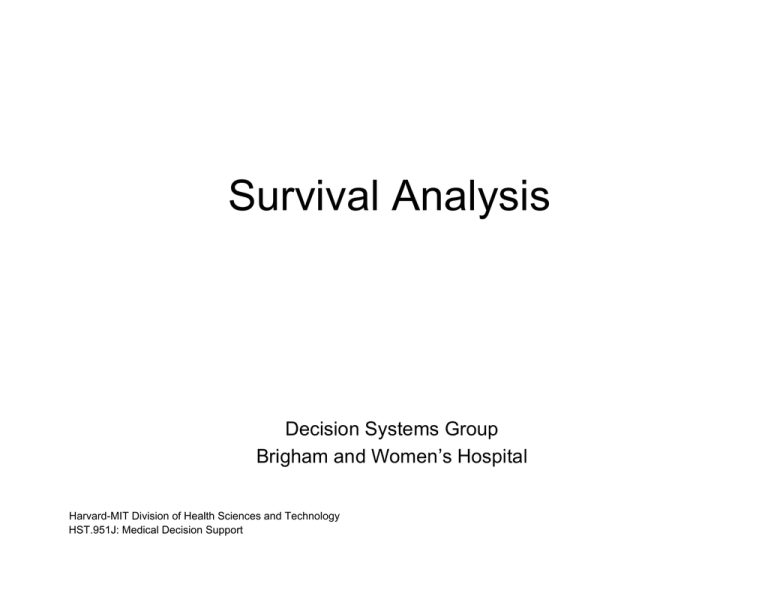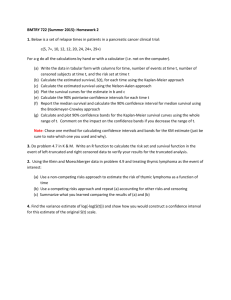Document 13581890
advertisement

Survival Analysis Decision Systems Group Brigham and Women’s Hospital Harvard-MIT Division of Health Sciences and Technology HST.951J: Medical Decision Support Outline Basic concepts & distributions – Survival, hazard – Parametric models – Non-parametric models Simple models – Life-table – Product-limit Multivariate models – Cox proportional hazard – Neural nets What we are trying to do Predict survival Variable 1 Variable 2 days Case 1 0.7 -0.2 8 Case 2 0.6 0.5 4 -0.6 0.1 2 0 -0.9 3 -0.4 0.4 2 -0.8 0.6 3 0.5 -0.7 4 (or probability of survival) • and evaluate performance on new cases Using these • and determine which variables are important Survival function Probability that an individual survives at least t • S(t) = P(T > t) • By definition, S(0) = 1 and S(∞)=0 • Estimated by (# survivors at t / total patients) 100 Survival (%) 0 time Unconditional failure rate • • • • • Probability density function (of death) f(t) = lim Δt-> 0 P(individual dies (t,t+Δt))/ Δt f(t) always non-negative Area below density is 1 Estimated by # patients dying in the interval/(total patients*interval_width) Same as # patients dying per unit interval/total Some other definitions • Just like S(t) is “cumulative” survival, F(t) is cumulative death probability • S(t) = 1 – F(t) • f(t) = - S’(t) Conditional failure rate • • • • AKA Hazard function h(t) = lim Δt-> 0 P(individual aged t dies (t,t+Δt))/ Δt h(t) is instantaneous failure rate Estimated by # patients dying in the interval/(survivors at t *interval_width) • So can be estimated by # patients dying per unit interval/survivors at t h(t) = f(t)/S(t) h(t) = -S’(t)/S(t) = -d log S(t)/dt Parametric estimation Example: Exponential • f(t) = λe-λt • S(t) = e-λt • h(t) = λ h(t) S(t) 1 λ t t Weibull distribution • Generalization of the exponential • For λ,γ > 0 γ γ-1 -λt • f(t) = γλ(λt) e γ -λt γ =2 • S(t) = e • h(t) = γλ(λt) γ-1 S(t) h(t) t γ =1 t h(t) t Non-Parametric estimation Product-Limit (Kaplan-Meier) S(ti) = Π (nj - dj )/ nj S(t) dj is the number of deaths in interval j nj is the number of individuals at risk Product is from time interval 1 to j One interval per death time 1 2 4 5 8 t Kaplan-Meier • Example • Deaths: 10, 37, 40, 80, 91,143, 164, 188, 188, 190, 192, 206, … Life-Tables • AKA actuarial method S(ti) = Π (nj - dj )/ nj dj is the number of deaths in interval j nj is the number of individuals at risk Product is from time interval 1 to j • Pre-defined intervals j are independent of death times Kaplan-Meier S(t) S(t) 1 1 2 2 1 2 3 Life-Table hazard survival density Simple models Multiple strata Multivariate models • Several strata, each defined by a set of variable values • Could potentially go as far as “one stratum per case”? • Can it do prediction for individuals? Cox Proportional Hazards • Regression model • Can give estimate of hazard for a particular individual relative to baseline hazard at a particular point in time • Baseline hazard can be estimated by, for example, by using survival from the Kaplan-Meier method Proportional Hazards λi = λ e−βxi where λ is baseline hazard and xi is covariate for patient Cox proportional hazards hi(t) = h0(t) e βxi • Survival Si(t) = [S0(t)] eβxi Cox Proportional Hazards hi(t) = h0(t) e βxi • New likelihood function is how we extimate β • From the set of individuals at risk at time j (Rj), the probability of picking exactly the one who died is h0(t) e βxi Σm h0(t) e βxm • • Then likelihood function to maximize to all j is L(β) = Π (e βxi / Σm e βxm ) Important details • Survival curves can’t cross if hazards are proportional • There is a common baseline h0, but we don’t need to know it to estimate the coefficients • We don’t need to know the shape of hazard function • Cox model is commonly used to interpret importance of covariates (amenable to variable selection methods) • It is the most popular multivariate model for survival • Testing the proportionality assumption is difficult and hardly ever done Estimating survival for a patient using the Cox model • Need to estimate the baseline • Can use parametric or non-parametric model to estimate the baseline • Can then create a continuous “survival curve estimate” for a patient • Baseline survival can be, for example: – the survival for a case in which all covariates are set to their means – Kaplan-Meier estimate for all cases What if the proportionality assumption is not OK? • Survival curves may cross • Other multivariate models can be built • Survival at certain time points are modeled and combined100 Survival (%) 0 A B time Single-point models • Logistic regression • Neural nets age gender blood pressure cholesterol smoking weight CHD in ta Problems • Dependency between intervals is not modeled (no links between networks) • Nonmonotonic curves may appear • How to evaluate? Survival (%) nonmonotonic curve 1 S(1)=0.9 patients followed for >1 year 2 3 S(2)=0.6 S(3)=0.4 >2 years 4 5 6 S(4)=0.3 S(5)=0.5 S(6)=0.3 Year >3 years >4 years >5 years >6 years input nodes: patient data output nodes: probability of survival in a given time point Accounting for dependencies • “Link” networks in some way to account for dependencies Survival (%) monotonic curve 0 1 3 2 Year S(3)=0.3 Output from lower network serves as input for upper network. 4 S(4)=0.2 5 Summary • Kaplan-Meier for simple descriptive analysis • Cox Proportional for multivariate prediction if survival curves don’t cross • Other methods for multivariate survival exist: logistic regression, neural nets, CART, etc. Censoring Non-censored Non-censored Type I Type II Left Study begin Study end







